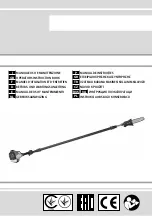
121
EN
g) When wheel is binding or when interrupting a cut for any reason, switch off the power tool
and hold the power tool motionless until the wheel comes to a complete stop. Never attempt
to remove the wheel from the cut while the wheel is in motion otherwise kickback may
occur.
Investigate and take corrective action to eliminate the cause of wheel binding.
h) Do not restart the cutting operation in the workpiece. Let the wheel reach full speed and
carefully re-enter the cut.
The wheel may bind, walk up or kickback if the power tool is restarted in
the workpiece.
i) Support panels or any oversized workpiece to minimize the risk of wheel pinching and
kickback.
Large workpieces tend to sag under their own weight. Supports must be placed under the
workpiece near the line of cut and near the edge of the workpiece on both sides of the wheel.
j) Use extra caution when making a “pocket cut” into existing walls or other blind areas.
The
protruding wheel may cut gas or water pipes, electrical wiring or objects that can cause kickback.
ADDITIONAL SAFETY RULES FOR YOUR CIRCULAR
SAW
1. Use only saw blades recommended by the manufacturer, which conform to EN 847-1, if intended for
wood and analogous materials.
2. Do not use any abrasive wheels.
3. Use only blade diameter(s) in accordance with the markings.
4. Identify the correct saw blade to be used for the material to be cut.
5. Use only saw blades that are marked with a speed equal or higher than the speed marked on the
tool.
ADDITIONAL SAFETY RULES:
1. Always wear a dust mask.
2. Always wear safety glasses or eye shields when using the cutting-off machine Everyday eyeglasses
have only impact-resistant lenses; they are NOT safety glasses. Following this rule will reduce the
risk of serious personal injury.
3. Always wear hearing protection during extended periods of operation. Following this rule will reduce
the risk of serious personal injury.
4. Keep your hands away from cutting area. Do not reach under the material being cut because the
nearness of the blade to your hand is hidden from your sight.
5. Do not use dull or damaged blades. Bent blades can break easily, or cause kickback.
6. Always check walls, floors and ceilings to avoid hidden power cables and pipes.
7. After long working period, external metal parts and accessories could be hot.
8. Only withdraw the blade from the cut when the blade has been stopped moving.
9. The pivoting blade foot must be held firmly against the material being cut to reduce saw vibration,
blade jumping and blade breakage.
10. Before cutting, check the cutting line is free of nails, screws, etc.
11. If possible, ensure the work-piece is firmly clamped to prevent movement.
12. Never stop the cutting blade by applying side pressure to the blade.
WARNING:
Some dust particles created by power sawing, contain chemicals known to cause
cancer, birth defects or other reproductive harm. Some examples of these chemicals are:
•
Lead from lead-based paints.
•
Crystalline silica from bricks and cement and other masonry products.
•
Arsenic and chromium from chemically treated lumber.
Your risk from these exposures varies, depending upon how often you do this type of work. To
Summary of Contents for CSC18LD.R
Page 2: ...2 1 2 3 4 5 6 7 9 10 8 11 13 16 12 14 15 17 18 ...
Page 3: ...3 A C C1 B1 B2 D1 D2 E2 E1 E3 E4 E5 1 2 ...
Page 25: ...25 FR ...
Page 48: ...48 ES ...
Page 70: ...70 PT ...
Page 92: ...92 IT ...
Page 115: ...115 EL ...
Page 135: ...135 EN ...
















































